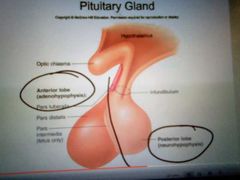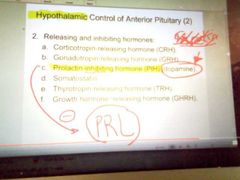![]()
![]()
![]()
Use LEFT and RIGHT arrow keys to navigate between flashcards;
Use UP and DOWN arrow keys to flip the card;
H to show hint;
A reads text to speech;
26 Cards in this Set
- Front
- Back
|
Chemical classification of hormones Amines (biogenic) |
Derived from tyrosine and tryptophan (EP &NEP) Example: hormones from the adrenal medulla, thyroid, and Pineal glands. |
|
|
Chemical classification of hormones Polypeptides (chain);& proteins (more than 100) |
Examples: antidiuretic hormone (ADH), insulin,;and growth hormone. |
|
|
Chemical classification of hormones
|
Gycoproteins are long polypeptides bound to a carbohydrate. Example: follicle-stimulating and luteinizing hormones |
|
|
Chemical classification of hormones Steroids |
Are lipids derived from cholesterol. Examples: testosterone, estradiol, progesterone, cortisol. Secreted by adrenal cortex and gonads. |
|
|
Hormone classifications by action Polar hormones: water soluble |
Cannot pass through plasma membrane Must be injected if used as drug Includes polypeptides, glycoproteins, catecholamines, norepinephrine, and epinephrine. |
|
|
Chemical classification of hormones Nonpolar: insoluble in water |
Often called lipophilic hormones Can enter Target cells directly Include steroids, thyroid hormone, and melatonin. Can be taken orally in pill form. |
|
|
Pepsin |
Digestion of protein Inactive form pepsinogen ( inside stomach) |
|
|
Prohormones |
Are inactive hormones that must be cut and spliced together to be active PRIOR to secretion Example: insulin |
|
|
Prohormones |
Are inactive hormones that must be modified within their Target cells |
|
|
Thyroid hormone |
Prehormone: Thyrocine (T3) => conversion of T4 to T3 occurs almost all tissues |
|
|
Testes |
Prehormone=>Testosterone Active product=> dihydrotestosterone (DHT) DHT and other 5 reduced androgens are doemwd in most androgen- dependent tissue Active product=> Estradiol 17 (E2) E2 is formed in the brain from testosterone, where it is believed to affect both endocrine function and behavior; small amounts of E2 are also produced in the testes |
|
|
Skin |
Prehormone: vitamin D3 Active products: 1,25- Dihydroxyvitamin D3 Conversion ( through hydroxylation reactions) occurs in the liver and the kidneys |
|
|
Hormone interactions |
A target cell is usually responsive to several different hormones Hormones may be antagonistic(working against each other), synergistic (working together), or permissive (one is needed for the other one). How a cell responds depends on the amount of hormone and the combination of all hormones. |
|
|
Permissive Effects ( one is needed for the other) |
Occur when one hormone makes the target cell more responsive to a second hormone Exposure to estrogen makes the uterus more responsive to progesterone Increased secretion of PTH (parathyroid hormone) makes the intestines more responsive to Vitamin D in calcium absorption |
|
|
Antagonistic Effects |
Occur when hormones work in opposite direction. Insulin and glucagon both affect adipose tissue. Insulin stimulates fat storage Glucagon stimulates fat breakdown. |
|
|
Effect of hormone concentration on tissue response Hormone half life |
I.e 100mg=> 50mg The time required for the plasma concentration of given amount of hormones to be reduced by half. The half-life of hormones circulating in the blood ranges from minutes to hours to days Most hormones are removed from the blood by the liver and converted to less active products. |
|
|
Pituitary gland Location |

|
|
|
Pituitary gland has 2 parts |

|
|
|
Anterior lobe (Pituitary Gland)
|
Adenohypophysis= hormone secretion Is gladular epithelium with two parts- pars distalis and pars tuberalis |
|
|
Posterior lobe (Pituitary gland) |
=> neurohypohysis => neurons hormones i.e. ADH, Oxytocin Is nervous tissue and also called the pars nervosa |
|
|
ADH and oxytocin hormones are produced in the___ |
Hypothalamus |
|
|
ADH and oxytocin are released in the _____ Pituitary glad |
Posterior lobe (neurohypohysis) |
|
|
Pituitary gland is attached to the hypothalamus by the _____. |
Infundibulum. |
|
|
Secreted -Anterior lobe (Pituitary gland) Hormones |
Growth hormone (GH) ** most tissue=bone, muscle, adipose tissue Thyroid-stimulating (TSH) **thyroid Adrenocorticotropic hormone (ACTH) ** adrenal cortex Gonadotropin=>Follicle-stimulating (FSH); Luteinizing hormone (LH) **gonads= testes & ovary Prolactin (PRL) **mammary gland and other sex accessory organs |
|
|
ADH and oxytocin are transported along axons of the________ to the posterior pituitary where they are stored. |
Hypothalamo-hypophyseal tract |
|
|
Hypothalamic Control of Anterior pituitary |

|

